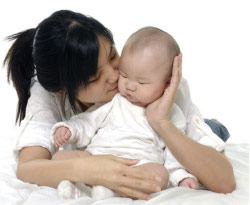In the previous issue of our Positive Parenting Guide (Issue 3), we introduced the topic of hearing loss and how you can detect its symptoms. In this issue, we explore the options that are available for you to determine whether or not your child has hearing loss, as this is especially important for high-risk babies/children.
Factors that determine whether a baby/child is in the high-risk category include (but are not limited to) family history of hereditary childhood sensorineural hearing loss, in-utero infections, cranio-facial anomalies, low birth weight (< 1.5kg), and/or bacterial/pneumococcal infections associated with sensorineural hearing loss.
Hearing loss can be caused by many conditions, and most children experience mild yet temporary loss of hearing when fluid gets in the middle ear because of allergies, colds, or infections like otitis media. If this condition is prolonged, it may also cause delays in your child’s speech development.
Diagnosing hearing loss can involve two steps: hearing screening and full hearing test.
Hearing screening
This involves a simple test to check for hearing loss. It is easy, painless, and can be done in minutes.
- Babies – should be screened for hearing loss before 1 month of age. It is better to have your baby screened after birth and before leaving the hospital. If your baby does not pass the screening, it is important that you schedule a full hearing test at no later than 3 months of age.
- Children – should have their hearing screened before they enter school or if you have any concerns about your child’s hearing. If he or she does not pass the screening, get a full hearing test done for your child as soon as possible.
Full hearing test
Children who fail a hearing screening should have a full hearing test. There are many types of tests, and these include:
- Audiometry test – A range of sounds with varying tones is played through a set of headphones/earphones. Your child will signal each time he hears a sound. This test can reveal the threshold of the levels of sounds your child can hear.
- Auditory Brainstem Response (ABR) test – This evaluates the function of the auditory nerve, cochlea and hearing pathways in a baby’s brain. Tiny electrical sensors are placed on the forehead, and on each ear lobe. Earphones are then placed over the ears, through which quiet clicking noises are played. The level of hearing is determined via sensors that measure the response of different areas of into the outer ear. It also checks for “echo” sounds bouncing back from the ear (otoacoustic emission). If there is no echo, your child might not necessarily have a hearing problem, but further tests will need to be carried out to find out why.
- OtoAcoustic Emission (OAE) – This simple and noninvasive test checks the response of the inner ear to sound. A small probe that emits sounds is inserted into the outer ear. It also checks for “echo” sounds bouncing back from the ear (otoacoustic emission). If there is no echo, your child might not necessarily have a hearing problem, but further tests will need to be carried out to find out why.
- Bone oscillator test – Checks how well vibrations pass through the ossicles (the three bones in the inner ear). A bone oscillator will be placed against the mastoid (bone behind the ear), which then transmits sound vibrations through the bone. This test reveals how well the ear detects sounds directed though the bone.
Why treat hearing loss
Since hearing loss can affect a child’s ability to develop speech, language and social skills, the earlier a child who is deaf or hard-of-hearing gets treatment or intervention services, the more likely he or she can maintain their development milestones. There are many treatment methods, but close monitoring and follow-ups are critical. Examples of different of communication options for children with hearing loss and their families, including:
- Learning other ways to communicate, such as sign language
- Hearing aids, cochlear implants, bone-anchored hearing aids and other devices.
- Medicine and surgery to correct some types of hearing loss like conductive hearing loss.
This article provides general information only, and should not substitute professional medical advice. Please seek consult a qualified paediatric audiologist if you have specific questions or concerns regarding your child’s hearing.






Comments